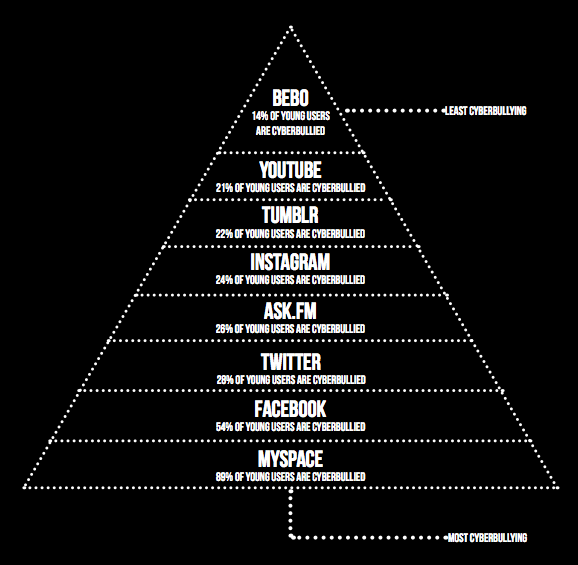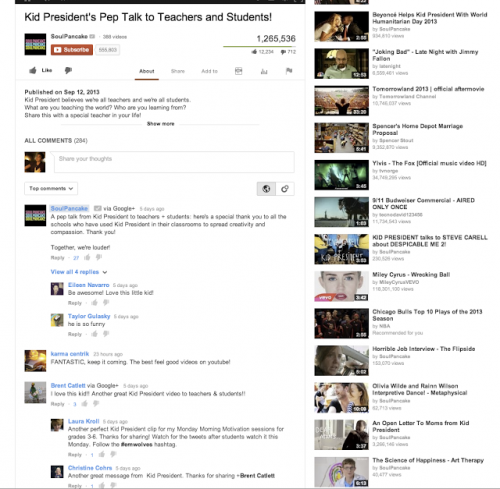Hannah Smith, Megan Meier, Hope Witsell, Gabriella Molina, Todd Loik, Rehtaeh Parsons, Erin Gallagher. These are the names of some of the young people who committed suicide after being bullied online.
The advance in technology, the rise in social media sites and the increasingly ubiquitous access to the internet combined with easy anonymity, has undoubtedly evolved the way that young people interact with one another. One negative focus over the past few years has been how kids are bullying and getting bullied online, and as social media managers, we’ve winced whenever a client has asked us to manage their communities on YouTube. Until now.
YouTube launched in 2005, and in 2006 it was one of the fastest growing websites with approximately 65,000 new videos being uploaded and 100 million video views each day. However, much to the frustration of Google, who took ownership in October 2006, it had also swiftly gained a reputation as a breeding ground for all the worst kinds of online behaviour – cultivating a hotbed for racism, anti-Semitism, sexism, and homophobia.
Perhaps surprisingly, according to Ditch the Label’s 2013 report on Cyberbullying (with 2000 British teens surveyed), YouTube is actually considered one of the least offensive websites for online bullying amongst young people. ‘Only’ 21% of the 68% of teens who use YouTube had experienced bullying through that platform. Indeed, YouTube ranked as the 2nd lowest bullying hotspot, only bettered by Bebo. MySpace, Facebook and Twitter took the top three spots for the most amount of bullying experienced by young people.
Regardless of where they ranked, YouTube understood they had to make it a more focused platform, and recently it announced that it had made changes to the way that its commenting functionality worked, using Google+ to power its comments. Phase 1 was already implemented in 2012 and if you have a YouTube account it’s likely you are already aware of these. In order to have a YouTube account, users required a Google account to log in with, so by encouraging users to post comments under their real name, there’s the assumption that the quality of conversation would rise and the flaming/bullying comments would subside.
For Phase 2, from the beginning of October 2013, users will see significant differences in the comments that rise to the top. These will be the more relevant ones rather than the most recent, with YouTube’s reasoning for this being ‘recent’ does not equal ‘relevant’.
As you can see in YouTube’s example below, comments from the account holder are at the top and the conversations are segmented by thread, as per Gmail’s email functionality.
How will YouTube’s changes affect brands?
The changes that YouTube are rolling out are designed to bring the best comments to the forefront and make moderation easier:
1. There is a new commenting hierarchy: Comments from the video’s creator, as well as popular personalities and committed discussions about the video, including those in your Google+ Circles will appear at the top.
2. Public & private conversations: To make it easier to follow, conversations will appear as a thread, similarly to how they appear in Gmail. Also, account holders can choose whether to hold public or private conversations that will either be seen by everyone on Google+ as well as YouTube, or only with people in your Google+ Circles. Or even just individuals.
3. Better tools for you to moderate comments: There’s a whole new set of tools to make moderation quicker and easier, allowing you to pre-moderate comments, block specific words or streamline your workflow by auto-approving comments from specified users. Instead of spending valuable time sifting through comments, time can be re-allocated to promoting existing videos, sharing new ones and engaging with user. You can also automatically hide certain users’ comments.
What should brands be doing to make the most of these changes?
It’s a clever move by Google – by providing the commenting through Google+, it suddenly increases the benefits of brands a) being on Google+ and b) being more active. Brands should optimize the use of the public and private conversations by opening up ‘exclusive’ interactions with its fans on Google+.
For example:
- Offer ‘exclusive’ interactions with fans on Google+
- Reach out to popular personalities to increase high quality comments
- Encourage high quality discussions around any videos to bring quality/valuable comments to the top
- The trend will move from commenting to actual conversations – so make sure you’re set up to deal with that
Of course, whilst YouTube’s changes naturally bring about advantages for brands and their engagement, this won’t mean the death of the troll. They will continue to lurk and muddy the waters in every way they can, but it does at least shed some hope that they’ll be somewhat muffled and hidden from the spotlight. YouTube has always been a place where lively and interesting discussion has taken place, but more often than not these have been buried deeply under the bad ones. It’ll be interesting to see whether these changes make a significant shift in culture over time.






Bullying has become an arising problem to on line Games and sites because kids have this need to interact. The problem is that as much as they are educated not to give private information, they go to the same sites and same chats, grouping themselves per schools which make their privacy null.